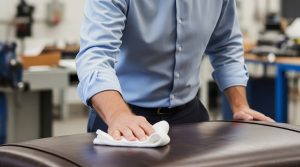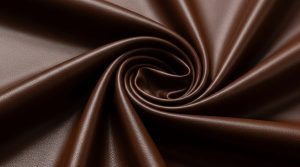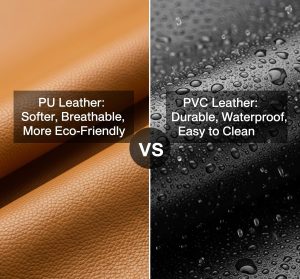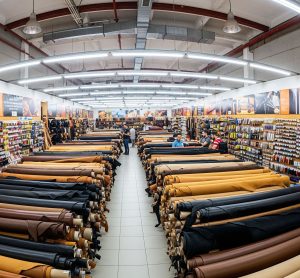3. Lave produtos de couro baratos na máquina, mas esteja ciente de que a lavagem de couro na máquina pode danificar a superfície. Se você tiver produtos de couro altamente resistentes ao desgaste, como botas e jaquetas, pode usar a lavagem na máquina em vez da lavagem à mão. Couro de cores vivas não é adequado para lavagem na máquina, pois fará com que a cor desbote. Produtos de couro com pequenos itens decorativos na superfície também não devem ser lavados na máquina, pois isso não apenas danificará suas roupas de couro, mas pode até danificar a máquina de lavar. Produtos de couro caros não são recomendados para lavagem na máquina. Recomenda-se que sejam limpos profissionalmente. Antes de lavar qualquer produto de couro, verifique a etiqueta do produto para ver se é lavável na máquina.

4. Entendendo Seu Couro Sintético: Por Que o Tipo de Material Importa
5. O couro sintético é dividido em couro PU, couro PVC, couro de microfibra, couro de silicone, couro PU à base de água e couro PU sem solvente. Nem todos os materiais de couro artificial podem ser lavados na máquina. O pré-requisito para a lavagem na máquina é que o couro deve ser especialmente tratado com 6. alta resistência ao desgaste 7. e resistência a rugas. A maioria dos couros artificiais é mais resistente à água do que o couro verdadeiro, então você deve 8. conhecer seu material de couro 9. antes de lavar.
10. A Regra de Ouro: Como Ler e Interpretar Etiquetas de Cuidado
11. Antes de comprar artigos de couro, verifique se há uma etiqueta de cuidado ou tag. Isso fornece instruções comuns de cuidado e lavagem.
- 12. As instruções de cuidado e lavagem devem ser organizadas na ordem de lavagem, branqueamento, secagem, engomar e limpeza a seco.
- 13. Uma etiqueta de cuidado deve incluir pelo menos quatro símbolos: lavagem, branqueamento, secagem e engomar. Uma etiqueta de limpeza a seco deve incluir apenas um símbolo de limpeza a seco, mas se nem todos os agentes de limpeza a seco forem aceitáveis, o solvente de limpeza a seco deve ser especificado.
- 14. Quando necessário, o símbolo é marcado com um símbolo de proibição (“X”).
- 15. Texto ou avisos adicionais devem ser colocados abaixo do símbolo na ordem usual de lavagem.
- 16. Etiquetas de cuidado podem não ser fornecidas nas seguintes situações: Peças de vestuário reversíveis e sem saco podem não ter uma etiqueta de cuidado permanente, mas as instruções de cuidado correspondentes devem ser exibidas na etiqueta; quaisquer métodos agressivos de lavagem, branqueamento, secagem, engomar e limpeza a seco não causarão danos significativos e irreversíveis à peça; roupas compradas para uso pessoal por empresas, governos e outras instituições públicas; e peças de vestuário feitas sob medida usando tecidos fornecidos pelo cliente.
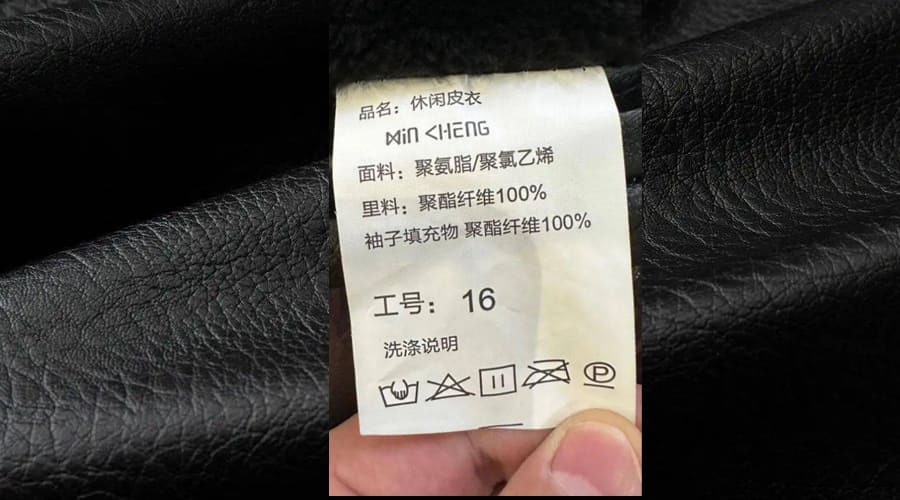
17. Os Riscos: O Que Pode Dar Errado ao Lavar Couro Sintético na Máquina?
18. A maioria dos produtos de couro artificial não é adequada para lavagem na máquina. O manuseio humano inadequado causará muitos danos aos produtos de couro. A lavagem na máquina pode fazer com que a superfície do couro desbote, descasque, rasgue, corroa, deforme, acelere o envelhecimento e até cause danos à máquina de lavar. Por favor, controle rigorosamente se seus produtos de couro podem ser lavados na máquina.
19. Preparação Pré-Lavagem: Reunindo Suprimentos e Tratando Manchas
20. Escolha itens de couro baratos que não estejam seriamente danificados. Antes de lavar, prepare-os de acordo com as seguintes diretrizes:
- 21. Despeje cerca de 60ml de sabão no dispensador de detergente; o sabão de Castela funciona como um detergente de roupa comum. Adicione o sabão de acordo com as instruções da sua máquina de lavar e, em seguida, lave em água fria.
- 22. Restaure o item de couro à sua forma original. Coloque-o plano ou pendure-o. Alise quaisquer vincos ou rugas que possam ter se formado durante a lavagem. Às vezes, você pode puxá-lo enquanto ainda está úmido para esticá-lo ligeiramente. Tenha cuidado ao esticar o couro; força excessiva pode fazer com que ele rache. Reparar o couro neste ponto pode ser difícil e caro.
- 23. Deixe o couro secar ao ar. Evite a luz solar direta, pois isso evaporará os óleos que mantêm o couro macio. Pendure-o em um cômodo iluminado para secar ao ar. Abra uma janela para promover a circulação do ar, o que o ajudará a secar mais rápido. Evite usar secador de cabelo ou outra fonte de calor direto para secar o couro. Se usar uma secadora, ajuste-a para calor baixo ou sem calor.
- 24. Aplique condicionador de couro. O condicionador de couro ajuda a proteger o couro e a restaurar sua textura original. Geralmente é aplicado no couro com uma toalha de papel ou um pano macio e sem fiapos. Uma vez aplicado o condicionador, o item de couro está imediatamente pronto para uso. Se você não tiver condicionador de couro comercial, também pode aplicar uma fina camada de azeite. Use o mesmo método que com o condicionador: aplique uma pequena quantidade de azeite em um pano e esfregue suavemente no couro.
25. Suprimentos Essenciais para uma Lavagem Segura
26. A limpeza de produtos de couro requer produtos de limpeza especializados. O uso de sabões agressivos pode facilmente danificar o couro. Manter a integridade do couro
- Purchase or make your own castile soap: Castile soap is relatively mild and not very irritating to leather. This includes any type of castile soap. Pour 60 ml into the wash.
- Leather conditioner: The pH value should be between 5 and 7.5. A pH above 7.5 or below 5 can damage the leather’s internal structure. Applying some conditioner to the surface of the leather will help protect the leather and extend its life.

How to Spot-Treat Common Stains Before Washing
We call this behavior pretreatment. ① Grease stains can be soaked up with paper towels or clean cloth to remove excess grease. ② Coffee and tea stains can be rinsed with cold water. Turn the leather garment inside out and rinse with cold water from the back of the stain to flush the stain out of the fibers. ③ Wine stains can be soaked up with paper towels. ④ Blood stains can be treated with cold water. Hot water will coagulate the protein in the blood. ⑤ Sweat stains can be treated with a paste of baking soda and water and applied to the stain. Let it sit for 30 minutes to an hour.
A Step-by-Step Guide to Machine Washing Faux Leather
Step 1: Preparing Your Garment for the Machine
Choose cheap leather clothes or leather pants, because machine washing leather itself will damage the leather. Expensive leather clothes will have a chance to damage the leather. Remove the objects or decorations inside the clothes before washing (small decorations embedded in the leather clothes are not recommended for washing)
Step 2: Choosing the Right Detergent
Buy or make your own castile soap; abrasive soaps can damage leather, while castile soap is milder and less irritating. Any type of castile soap will work. If you can’t buy one, you can also make your own.

Step 3: Selecting the Correct Cycle and Temperature Settings
Place the leather item in the washing machine and run a gentle cycle. To prevent the leather item from being excessively bumped and agitated while washing, you can put a few black garments in to absorb the impact. Run the washing machine on the gentlest cycle and, if possible, turn the leather item inside out first, close all zippers, and fasten all fasteners. This will help “rinse” the stain out and prevent damage to the visible parts of the leather.
Step 4: Placing the Item in the Washer and Starting the Cycle
Run the wash cycle. Keep a close eye on your leather item while it’s in the washing machine. Remove it from the washing machine as soon as possible after washing, and don’t let it dry out. If the leather is allowed to dry out while wrinkled or deformed, it will be permanently deformed.
The Absolute "Don'ts" of Washing Faux Leather
- Excessive cleaning: Frequent cleaning will only cause the leather surface to wear and discolor quickly, shortening its lifespan.
- Cleaning products: Avoid using alcohol wipes, bleach, strong acid or alkaline cleaners, stain removers, turpentine, nail polish remover, furniture polish, or wax. These products are highly corrosive and will damage and corrode the leather surface coating, rendering it irreparable.
- Cleaning tools: Avoid using scouring pads, steel wool, hard-bristled brushes, tech sponges, and rough cloths, as they will scratch the leather surface and dull its luster.
- High-temperature environments: Avoid direct sunlight and hot air from hair dryers; these are the natural enemies of artificial leather and can cause it to soften, deform, and accelerate aging and cracking.
- Maintenance products: Avoid using leather maintenance oils, mink oils, or shoe polish, as these can deteriorate and damage the leather.
The Art of Drying: Post-Wash Care for Faux Leather
Why You Must Avoid the Tumble Dryer
The tumble dryer uses a high-temperature drying method. The leather surface is coated. High temperature will cause the plastic coating on the coating surface to melt, bubble, shrink, deform, etc., and will also cause the coating to peel off. High temperature will peel off the adhesive between the bottom layer and the fabric; even if the temperature is not high, long-term drying will cause the plasticizer in the material to be lost, making the originally soft leather stiff and brittle.
How to Properly Air-Dry Your Garment
We recommend using natural air drying and placing the shaped leather products in a cool, well-ventilated place to dry naturally.
Restoring Softness and Shine After Washing
Use a special protective agent or polish sprayed on a clean soft cloth, avoid spraying directly on the leather surface; wipe the surface of the leather product evenly with a soft cloth, it will form a thin protective layer, wait for 5-10 minutes, use another piece of cloth to gently wipe off the excess liquid, and perform a light polish to give the leather product a natural, non-greasy luster
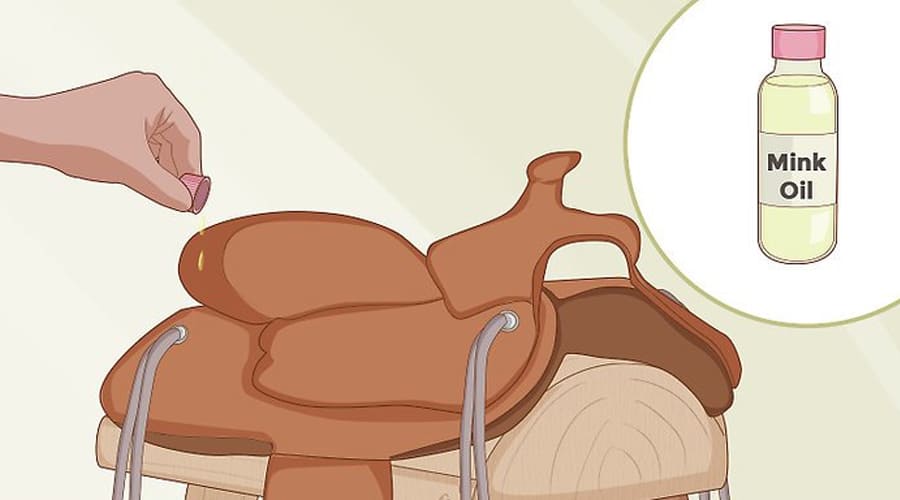
Alternative Cleaning Methods for Delicate Items
When and How to Hand Wash Faux Leather
Hand washing leather products is safer than machine washing. It can effectively deal with local scratches and dirt and achieve a deep cleaning effect. The safest way is to have a professional clean the leather. The following are the ways to hand wash leather products:
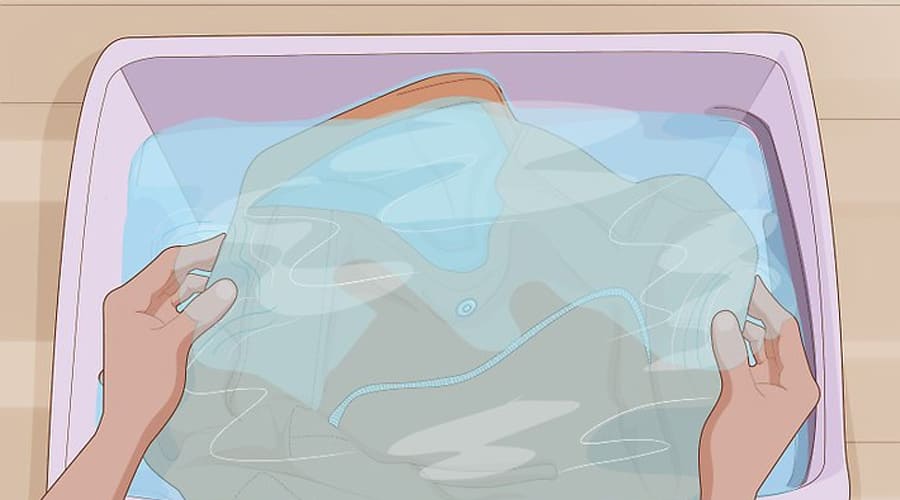
- Make a liquid (castile soap): Pour a small amount of castile soap into a bowl of distilled water. [2] Stir the solution by hand or with a blender to distribute and lather the soap. ① To better protect the leather, use a soap specifically formulated for leather cleaning. Many general merchandise stores, hardware stores, and craft stores sell this type of soap. ② If you don’t have castile soap or a leather cleaner, you can substitute a mild soap, such as dish soap. ③ Test the cleaning solution on an inconspicuous area of the leather to ensure it does not damage the leather before moving on to more visible areas.
- Dip a soft, lint-free cloth into the cleaning solution. Microfiber is best, but a regular rag will do if you have no other options. Avoid using harsh, abrasive tools, such as scouring pads. These can scratch the leather and cause the finish to become dull and cloudy. Generally, avoid using harsh cleaning products when cleaning leather. They can cause a negative reaction and cause the leather surface to deform.
- Wipe the leather with the cloth to remove any dirt, following the grain of the leather. For set-on dirt or stubborn stains, rub with gentle, circular motions. Try not to completely soak the leather while cleaning, as this can damage it. If the leather becomes too wet during cleaning, wait for it to dry slightly before continuing.
- Use another clean cloth to wipe away any soap residue and any remaining dirt. After cleaning the leather, be very careful to remove all soap residue, as this can dry out the leather and cause it to crack. Dampen a clean, lint-free cloth with clean water and wipe the now-dirt-free surface of the leather.
- Allow the leather item to air dry. Hang it on a hanger or place it on a suitable surface, such as a chair or clothes drying rack, to ensure it remains in shape. Allow it to air dry completely. Avoid direct sunlight, as this can cause the leather to dry out and crack.
- Apply leather conditioner. This final step protects the leather and restores its smooth finish. Follow the conditioner’s instructions for best results. The general practice is to use a clean, dry, lint-free cloth to apply conditioner and then polish the leather. ① Over time, the oils that help keep leather soft and flexible will gradually disappear from the leather surface. Especially after cleaning, if leather conditioner is not applied to replenish these oils, the leather product will become very fragile and easily damaged. ② Never use products such as mink oil and leather wax to clean finished leather. They will damage the appearance of such leather products and the polish used in the finishing.
Dealing with Tough Odors
Leather product odors primarily come from the plastics, solvents, adhesives, and surface coatings used during the production process. Odors from these products should be treated in the following ways:
- Natural ventilation: Place the leather product in a cool, dry, and well-ventilated area, such as a shaded balcony or near a window. Leave it open to ensure air circulation to all surfaces. This can take anywhere from a few days to two weeks.
- Baking soda adsorption: To remove odors from leather products like bags and shoes, place baking soda in a breathable cloth bag and place it inside the bag or shoe. Then, seal the bag or shoe in a larger bag and leave it there for at least one day. Finally, remove the baking soda with a soft-bristled vacuum cleaner or a clean cloth.
- Activated charcoal or coffee grounds: Place activated charcoal or coffee grounds in a sealed container with the artificial leather product. Because activated charcoal and coffee grounds have a porous structure and a strong adsorption capacity, they attract odor molecules like a magnet.
Final Verdict: Is Machine Washing Worth the Risk?
It is not recommended to take risks. If your leather products are expensive or have decorations, it is recommended that you go to a professional leather cleaning shop to clean them to ensure the safety and life of your products.




